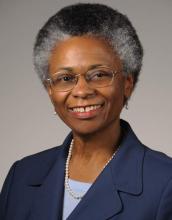
December, 2020
DR. BERNARD'S REFLECTIONS

Marie A. Bernard, MD
Acting Chief Officer for Scientific Workforce Diversity
Discussions of disparities related to underrepresented populations in the U.S. research enterprise often center on issues such as grant funding and representation within the ranks of faculty and leadership. However, more subtle career-related issues can also affect workforce diversity and may be hidden in plain sight: citizenship tasks, academic publishing inequities, and disparate conference opportunities. Altogether, they may reinforce diminishing representation through a "death by a thousand cuts."
With that in mind, this month’s issue features publications highlighting such disparities, as well as evidence-based approaches and recommendations for addressing these “unseen” barriers in the scientific workforce. Overall, the reports remind us that examining all aspects of the scientific enterprise may be needed to establish a diverse and inclusive scientific workforce.
Citizenship Tasks: Gender and Minority Taxes
"Citizenship tasks" are an often unaddressed factor affecting women and underrepresented faculty. These tasks are gender- or racial-based expectations to fulfill uncompensated duties within the organization’s interests (e.g., serving on committees to advance diversity efforts, notetaking, volunteering, etc.). It is often a concern that such tasks come at the cost of focusing on career advancement opportunities.
Armijo and colleagues recently assessed this phenomenon by surveying 389 self-identified female doctors who attended a national women physician’s leadership conference. Nearly 50% reported spending more time on citizenship tasks than their male counterparts. However, older women (50 years or older) more often reported feeling obligated to volunteer for citizenship tasks because of gender. Additionally, higher proportions of physicians of color noted race/ethnicity as a factor in feeling obligated to volunteer for uncompensated citizenship tasks.
While a major limitation is that men were not respondents, aspects of this study are echoed in another recent publication. In it, Trejo highlights similar issues for Black, Hispanic or Latino, and Indigenous faculty. However, she does note there are occasional benefits including expanding professional networks that help boost scientific research efforts (like leveraging new connections to develop successful NIH grant proposals). While these benefits exist, she also encourages the overall use of metrics and tracking to ameliorate these "unseen" issues.
In total, the two publications offer a record of the potential negative effects of supplementary tasks in academia/academic medicine and the need to be vigilant in addressing them.
Disparities in Academic Publishing
Academic publishing supports the meritocratic currency by which trainees and faculty advance their careers and receive grants. However, results from a recent study by Hagan and colleagues suggest all may not be equal within the space of academic publishing. Their findings highlight disparate outcomes for women in the Association for Microbiology’s (ASM’s) 15 journals over a six-year span. In short, they find that women were underrepresented as senior authors in ASM publications. Additionally, manuscripts with female corresponding authors or female senior authors saw more negative outcomes (e.g., more likely to be rejected) than those submitted by men. The authors suggest a variety of factors may be at play: topic choice, publisher bias, institutional preference/prestige, and others.
The study does have its limitations in that it relies on a computer-based algorithm to infer the authors’ gender and the examination is limited to one field of science, microbiology. However, the authors conclude there is a need to improve representation and address the structural penalties against women. In the future, it will be important to assess publishing at other journals to understand the full extent of these potential disparities in other fields.
Disparities in Academic Conferences Opportunities
Women are underrepresented in academic conferences, particularly in visible positions such as speaking roles. This is a notable impediment because conferences offer critical career opportunities to build research networks and increase visibility. A recent study by Corona-Sobrino and colleagues presents a new tool for evaluating gender inequalities at academic conferences. The approach uses extensive literature searches to identify conference-specific disparity indicators—which are further prioritized by experts and then weighted by algorithms—to provide a quantitative assessment of gender disparities at active academic conferences. Using this tool, the authors identify key areas of low performance for a January 2020 conference and suggest recommendations based on academic literature to address such disparities in future years.
While this is a forward-thinking approach to conference assessment, it is a notably time-intensive process that may introduce some opportunities for bias based on the selection of academic experts needed for the in-depth interview portion of the approach. Even with this in mind though, the authors make strides in advancing the conversation about using evidence-based tools to monitor underrepresentation in subtle facets of the scientific enterprise.
This Month’s Blog Posts
If you have not had an opportunity, please review this month’s blog posts at our website.
- The Importance of Science Identity for Inclusion
- Support for Inclusive Excellence Through Cohort Hiring: Funding Opportunities Released
- Barriers to Inclusion of Individuals with Disabilities in the Scientific Workforce

The links above are pulled from the top news articles trending on the subject of diversity in science and technology.
The stories selected are not a reflection of the views of the National Institutes of Health.

